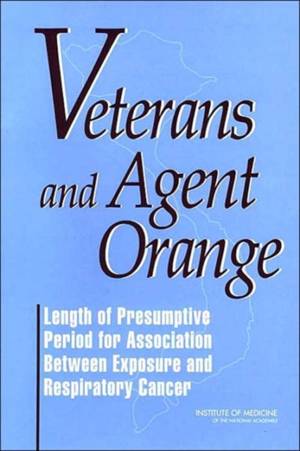
- Afhalen na 1 uur in een winkel met voorraad
- Gratis thuislevering in België vanaf € 30
- Ruim aanbod met 7 miljoen producten
- Afhalen na 1 uur in een winkel met voorraad
- Gratis thuislevering in België vanaf € 30
- Ruim aanbod met 7 miljoen producten
Veterans and Agent Orange
Length of Presumptive Period for Association Between Exposure and Respiratory Cancer
Institute of Medicine, Board on Health Promotion and Disease Prevention, Committee to Review the Health Effects in Vietnam Veterans of ExOmschrijving
From 1962 to 1971, US military forces sprayed herbicides over Vietnam to strip the thick jungle canopy that helped conceal opposition forces, to destroy crops that enemy forces might depend on, and to clear tall grasses and bushes from the perimeters of US base camps and outlying fire-support bases. Mixtures of 2,4-dichlorophenoxyacetic acid (2,4-D), 2,4,5-trichlorophenoxyacetic acid (2,4,5-T), picloram, and cacodylic acid made up the majority of the herbicides sprayed. Agent Orange was a 50:50 mixture of 2,4-D and 2,4,5-T. At the time of the spraying, 2,3,7,8-tetrachlorodibenzo-p-dioxin (TCDD, one form of dioxin) was an unintended contaminant from the production of 2,4,5-T and was present in Agent Orange and some other formulations sprayed in Vietnam.
In 1991, because of continuing uncertainty about the long-term health effects on Vietnam veterans of the herbicides sprayed, Congress passed Public Law 102-4, the Agent Orange Act of 1991. In response to the request from the VA, IOM extended the service of the Committee to Review the Health Effects in Vietnam Veterans of Exposure to Herbicides that was responsible for Update 2002 to address the question of presumptive period and respiratory cancer. The charge to the committee was to undertake a review and evaluation of the evidence regarding the period between cessation of exposure to herbicides used in Vietnam and their contaminants (2,4-D, 2,4,5-T and its contaminant TCDD, cacodylic acid, and picloram) and the occurrence of respiratory cancer.
Specificaties
Betrokkenen
- Auteur(s):
- Uitgeverij:
Inhoud
- Aantal bladzijden:
- 74
- Taal:
- Engels
Eigenschappen
- Productcode (EAN):
- 9780309091886
- Verschijningsdatum:
- 2/05/2004
- Uitvoering:
- Paperback
- Formaat:
- Trade paperback (VS)
- Afmetingen:
- 152 mm x 229 mm
- Gewicht:
- 136 g

Alleen bij Standaard Boekhandel
Beoordelingen
We publiceren alleen reviews die voldoen aan de voorwaarden voor reviews. Bekijk onze voorwaarden voor reviews.











